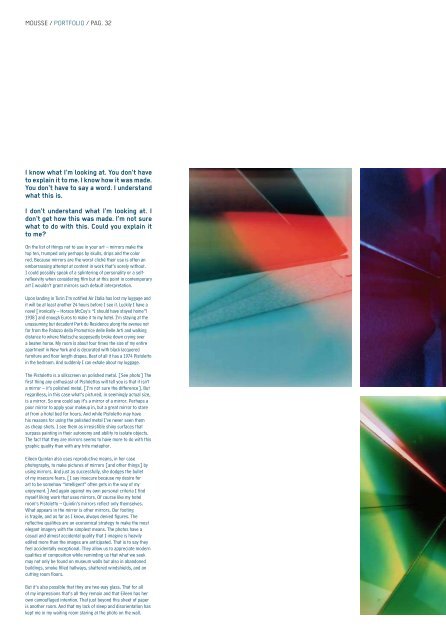contemporary art magazine issue # sixteen december ... - Karyn Olivier
contemporary art magazine issue # sixteen december ... - Karyn Olivier
contemporary art magazine issue # sixteen december ... - Karyn Olivier
Create successful ePaper yourself
Turn your PDF publications into a flip-book with our unique Google optimized e-Paper software.
MOUSSE / PORTFOLIO / PAG. 32<br />
I know what I’m looking at. You don’t have<br />
to explain it to me. I know how it was made.<br />
You don’t have to say a word. I understand<br />
what this is.<br />
I don’t understand what I’m looking at. I<br />
don’t get how this was made. I’m not sure<br />
what to do with this. Could you explain it<br />
to me?<br />
On the list of things not to use in your <strong>art</strong> – mirrors make the<br />
top ten, trumped only perhaps by skulls, drips and the color<br />
red. Because mirrors are the worst cliché their use is often an<br />
embarrassing attempt at content in work that’s sorely without.<br />
I could possibly speak of a splintering of personality or a selfreflexivity<br />
when considering film but at this point in <strong>contemporary</strong><br />
<strong>art</strong> I wouldn’t grant mirrors such default interpretation.<br />
Upon landing in Turin I’m notified Air Italia has lost my luggage and<br />
it will be at least another 24 hours before I see it. Luckily I have a<br />
novel [ironically – Horace McCoy’s “I should have stayed home”!<br />
1938] and enough Euros to make it to my hotel. I’m staying at the<br />
unassuming but decadent Park du Residence along the avenue not<br />
far from the Palazzo della Promotrice delle Belle Arti and walking<br />
distance to where Nietzsche supposedly broke down crying over<br />
a beaten horse. My room is about four times the size of my entire<br />
ap<strong>art</strong>ment in New York and is decorated with black lacquered<br />
furniture and floor length drapes. Best of all it has a 1974 Pistoletto<br />
in the bedroom. And suddenly I can exhale about my luggage.<br />
The Pistoletto is a silkscreen on polished metal. [See photo] The<br />
first thing any enthusiast of Pistolettos will tell you is that it isn’t<br />
a mirror – it’s polished metal. [I’m not sure the difference]. But<br />
regardless, in this case what’s pictured, in seemingly actual size,<br />
is a mirror. So one could say it’s a mirror of a mirror. Perhaps a<br />
poor mirror to apply your makeup in, but a great mirror to stare<br />
at from a hotel bed for hours. And while Pistoletto may have<br />
his reasons for using the polished metal I’ve never seen them<br />
as cheap shots. I see them as irresistible shiny surfaces that<br />
surpass painting in their autonomy and ability to isolate objects.<br />
The fact that they are mirrors seems to have more to do with this<br />
graphic quality than with any trite metaphor.<br />
Eileen Quinlan also uses reproductive means, in her case<br />
photography, to make pictures of mirrors [and other things] by<br />
using mirrors. And just as successfully, she dodges the bullet<br />
of my insecure fears. [I say insecure because my desire for<br />
<strong>art</strong> to be somehow “intelligent” often gets in the way of my<br />
enjoyment.] And again against my own personal criteria I find<br />
myself liking work that uses mirrors. Of course like my hotel<br />
room’s Pistoletto – Quinlin’s mirrors reflect only themselves.<br />
What appears in the mirror is other mirrors. Our footing<br />
is fragile, and as far as I know, always denied figures. The<br />
reflective qualities are an economical strategy to make the most<br />
elegant imagery with the simplest means. The photos have a<br />
casual and almost accidental quality that I imagine is heavily<br />
edited more than the images are anticipated. That is to say they<br />
feel accidentally exceptional. They allow us to appreciate modern<br />
qualities of composition while reminding us that what we seek<br />
may not only be found on museum walls but also in abandoned<br />
buildings, smoke filled hallways, shattered windshields, and on<br />
cutting room floors.<br />
But it’s also possible that they are two-way glass. That for all<br />
of my impressions that’s all they remain and that Eileen has her<br />
own camouflaged intention. That just beyond this sheet of paper<br />
is another room. And that my lack of sleep and disorientation has<br />
kept me in my waiting room staring at the photo on the wall.<br />
Eileen Quinlan (from left to right)<br />
Smoke & Mirrors #209, 2007 - courtesy: Miguel Abreu Gallery, New York<br />
Fahrenheit #32, 2008 - courtesy: Sutton Lane, London / Paris<br />
Yellow Goya, 2007 - courtesy: Miguel Abreu Gallery, New York<br />
Smoke & Mirrors #208, 2007 - courtesy: Miguel Abreu Gallery, New York<br />
The Black & White Version of Smoke & Mirrors #233, 2007 - courtesy: Miguel Abreu Gallery, New York<br />
Night Flight #8, 2008 - courtesy: Galerie Daniel Buchholz, Cologne / Berlin<br />
Orchidism, 2007 - courtesy: Miguel Abreu Gallery, New York<br />
Red Edges, 2007 - courtesy: Miguel Abreu Gallery, New York<br />
MOUSSE / PORTFOLIO / PAG. 33


